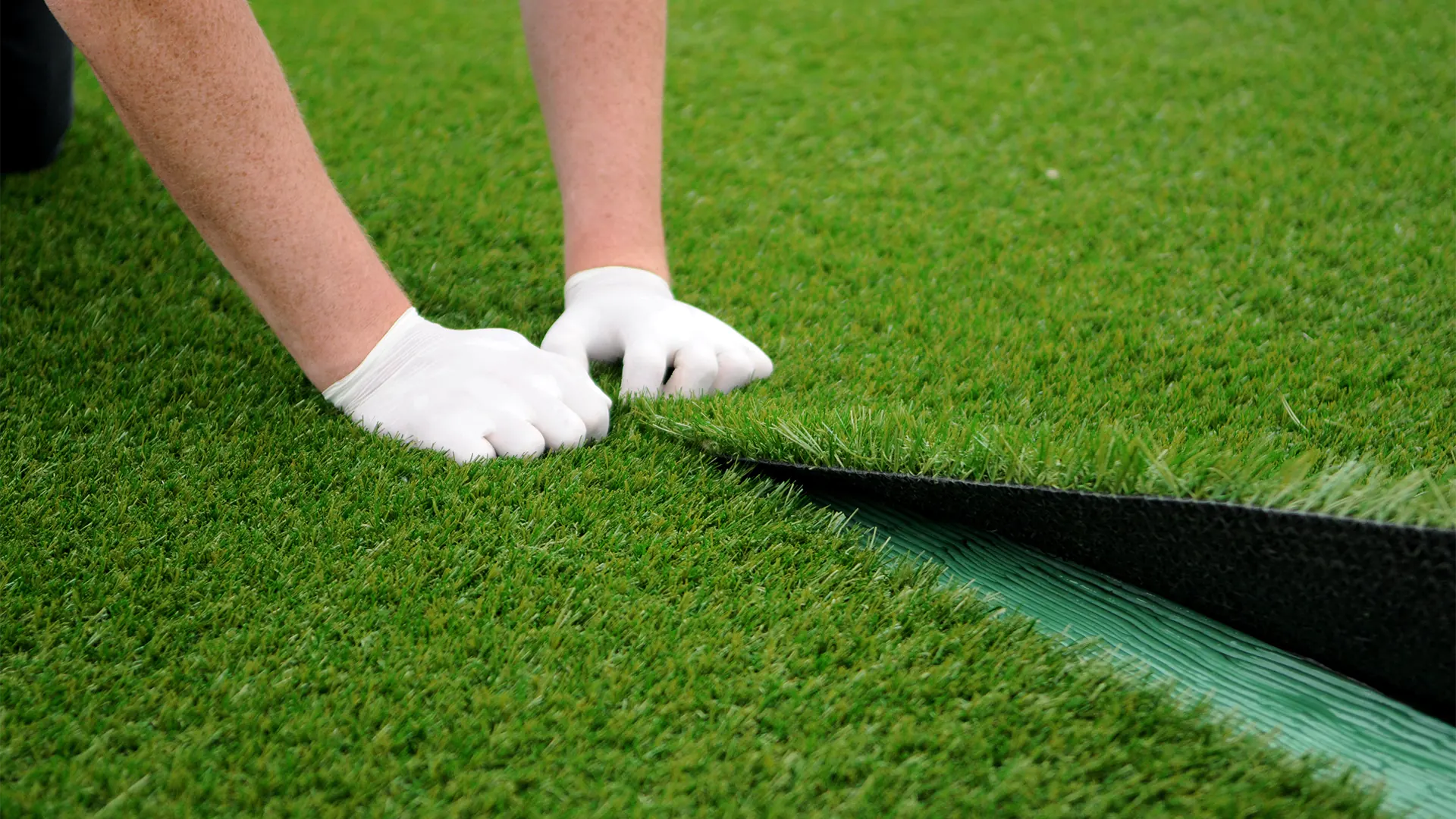
Synthetic and natural grass are beautiful fixtures of Australian homes. Many residences that have expansive lawns and outdoor spaces feature either of these two types of grass. Regardless of your preference, each option has unique advantages and disadvantages.
Deciding between the two alternatives can be challenging. As trusted artificial grass Sydney experts with extensive industry experience, we can help you choose the appropriate option.
This blog will explain the pros and cons of synthetic grass vs natural grass to help homeowners make a sound, long-term buying decision.
Synthetic Grass Summary
Synthetic grass is made of synthetic, artificial fibres that mimic the appearance of its natural counterpart.
Artificial grass blades are green with varying pile heights. Manufacturers machine-stitch them onto a robust backing (the material layer supporting the synthetic grass fibres), similar to how carpets are made. Nowadays, cutting-edge technology has allowed artificial turf to resemble natural grass closely.
Many homeowners appreciate the convenience of synthetic grass because of its low-maintenance features. They can relax on weekends knowing they don’t have to mow their lawns, offering a sense of comfort and stress-free lifestyle.
Artificial grass provides families a lush, natural environment year-round and withstands harsh climates. Whether you live in Brisbane, the Gold Coast, or Sydney, you will enjoy the benefits of a hassle-free lawn that looks like authentic grass.
Synthetic Grass Pros
Artificial grass has the following benefits:
Low maintenance
Synthetic turf does not require watering, fertilising, and mowing. It provides homeowners with a convenient, aesthetically pleasing alternative to natural grass.
Remember that artificial turf requires maintenance, including weekly cleaning and eliminating spills, stains, pet waste, and weeds. However, it’s not as tedious as natural grass upkeep.
Weather resistant
Artificial grass can endure the harsh Aussie summers, winters, and torrential rainfalls. Depending on how you maintain your turf, it will remain green and fresh year-round.
Time saver
Since synthetic turf requires no mowing, fertilising, and watering, homeowners save plenty of time, allowing them to focus on essential matters.
Pet friendly
Homeowners can rejoice because artificial grass remains resilient despite frequent pet waste exposure.
Nevertheless, pet owners must remove the waste, rinse the affected area thoroughly with water, and apply a turf-safe enzyme cleaner to ensure the grass remains clean and eliminate lingering odours.
Cost-effective alternative
Although artificial grass can be expensive upfront, its long-term low maintenance means homeowners can break even and save money over time.
If you choose synthetic turf, you don’t have to purchase pesticides, fertilisers, a lawn mower, rakes, hoses, and other equipment to maintain your lawn.
Versatile: You can use synthetic turf in various settings, including homes, decking, poolsides, terraces, playgrounds, offices, gyms, restaurants, bars, hotels, and sports stadiums.
Artificial grass’ versatility empowers homeowners to be creative with their outdoor areas.
Child-friendly
Since artificial grass requires no chemical or pesticide treatment, it’s safe for children to play on.
Unlike natural grass, which produces pollen, synthetic turf has no allergens, offering parents valuable peace of mind and reassurance.
Synthetic Grass Cons
Artificial grass has the following disadvantages:
Steep upfront costs
Although artificial grass is a low-maintenance alternative, homeowners must pay significant installation costs, including grass removal, ground preparation, and labour costs.
Surface heat
Synthetic turf retains considerably more heat than its natural counterpart. Artificial grass also doesn’t cool down naturally as the authentic version, so walking on the former can be challenging during the oppressive Aussie summers.
Possible weed growth
Weed can develop on artificial grass on the surface, around the edges, and through drainage holes, especially after incorrect installation.
Drainage issues
Modern synthetic grass can drain up to 60 litres of water per minute during torrential rainfall.
However, poor installation, incorrect base preparation, or heavy soil composition may cause pooling and costly repairs over time.
Negative environmental impact
Artificial grass contains toxic components, including phthalates, bisphenol-A (BPA), lead, mercury, and cadmium, which have a negative environmental impact.
Natural Grass Summary
As the term implies, homeowners cultivate this grass from natural varieties in many Australian gardens.
Although requiring high maintenance, natural grass is a sustainable, aesthetically pleasing, and environmentally sound choice for many residents.
Natural Grass Pros
Natural grass benefits include the following:
Improved air quality
Natural grass purifies the air and eliminates impurities, including carbon dioxide. Dew and precipitation transfer these contaminants into the root zone and the soil, where microbes decompose them.
Natural grass also produces oxygen that meets the daily requirements of four individuals. Hence, it’s the perfect choice for homeowners who want fresh air in their outdoor spaces.
Natural cooling effect
Natural grass produces a soothing, cooling effect that minimises home cooling requirements and lowers monthly electricity bills.
Unlike synthetic turf that retains heat, the natural version suits homeowners who want to beat the oppressive Australian heat. Eight average natural gardens produce similar effects as 70 tonnes of air conditioning.
Positive environmental impact
Natural grass minimises water and wind erosion. It secures soil firmly in place, retains soil nutrients, and preserves biodiversity.
Enhanced physical and mental well-being
Studies have consistently shown that natural greenery exposure lowers stress, blood pressure, and muscle tension and improves attention span.
Playing, frolicking, and organising family barbecues on natural grass significantly enhance physical and mental well-being.
Natural Grass Cons
Natural grass has the following disadvantages:
High maintenance
Natural grass requires frequent watering, mowing, fertilising, and pest control. These maintenance strategies require time, money, and effort.
Frequent water usage
Frequent water use means higher monthly or quarterly water bills. This natural grass requirement can be challenging for homeowners who reside in drought-prone areas.
Durability and inconsistency
Frequent use and inclement weather can result in bare patches, uneven surfaces, and natural grass wear and tear over time.
Unfortunately, inconsistent surfaces can become tripping or slipping hazards, increasing injury risk and compromising the quality of play.
We strongly urge homeowners to hire a reputable service provider to fix these issues and improve natural grass conditions for long-term safety and well-being.
Benefits of Synthetic Turf Vs Natural Grass
Choosing between artificial and natural grass requires careful thought and consideration. Here’s a breakdown of each grass type to help you make a sound, informed buying decision.
Efficiency And Maintenance
Artificial grass
Synthetic turf is efficient because it doesn’t require mowing, fertilising, or watering. Synthetic turf is perfect for busy families who want an aesthetically pleasing, low-maintenance lawn.
Natural grass
Authentic grass can be challenging to maintain because it requires frequent watering, fertilising, and mowing. This grass type can be a double-edged sword: it can be a therapeutic hobby and a heavy burden.
Upfront And Long-Term Costs
Artificial grass
Synthetic turf requires steep upfront payments and minimum long-term maintenance fees. Homeowners on tight budgets can break even and increase their savings over time.
Natural grass
Natural grass is the opposite of its artificial counterpart: the former is cheaper to install and costlier to maintain. Regular pest control and higher water bills can significantly increase expenses.
Endurance And Lifespan
Artificial grass
Homeowners who maintain synthetic grass property will enjoy its 15- to 20-year lifespan. Synthetic turf resists wear and tear and heavy foot traffic.
It’s also a good choice for pet owners because it can endure animal waste with timely intervention and proper maintenance.
Natural grass
The natural version isn’t as durable in heavy-traffic areas as synthetic turf. Depending on the extent of the damage, your service provider may recommend patching or replacement.
Aesthetics
Artificial grass
Synthetic turf provides homeowners a lush, picturesque natural grass appearance. However, it doesn’t fully capture the latter’s long-term aesthetic appeal.
Natural grass
Regardless of season, natural grass offers homeowners timeless aesthetic appeal.
Environmental Impact
Artificial grass
Synthetic turf contains toxic components that negatively impact the environment.
Natural grass
Authentic grass reduces wind and soil erosion, retains soil nutrients, and maintains biodiversity, making a positive environmental impact.
Customising Turf Choice Based On Landscape
Your choice between natural or artificial grass will depend on several factors. As artificial grass Brisbane specialists with extensive industry experience, we strongly recommend considering their feasibility to your specific setting.
Home Gardens
We recommend synthetic grass for small gardens or thin turf (areas with sparse grass growth). It’s also ideal for families who prefer low-maintenance alternatives or people with limited mobility who consider yardwork challenging.
Conversely, natural grass suits expansive lawns and families who enjoy gardening.
Commercial Spaces
Artificial grass’s durability makes it ideal for busy, high-traffic areas like office buildings or retail spaces.
On the other hand, we recommend natural grass for commercial spaces with in-house gardeners, such as luxury hotels, because of its high-maintenance nature.
Sporting Venues
Synthetic turf is common in team sports stadiums, such as those for rugby, Australian rules football, and soccer, because of the high foot traffic volume and intensity. Artificial grass can withstand constant running, jumping, and trampling.
Sports like cricket and golf require natural grass because of performance, playability, comfort, and safety requirements.
Choosing between natural and artificial grass for sporting venues depends on the event’s nature and unique requirements.
Pet Areas
Artificial grass is better for pet owners since they’re easier to sanitise and maintain than its natural counterpart.
However, people who prefer natural pet environments for playing and frolicking can opt for authentic grass.
Playgrounds And Schools
Synthetic grass works well in playgrounds and schools because it is durable enough to withstand these high-traffic areas.
Its cushioned surface helps minimise the effects of tripping, falling, and slipping, which occur frequently in these places.
Conversely, schools and playgrounds that prefer natural environments can use real grass, although it requires frequent upkeep for aesthetic and safety reasons.
Conclusion
Synthetic grass and natural turf have distinct advantages and disadvantages. Deciding between these alternatives entails lifestyle, maintenance, budget, environmental, and specific usage considerations.
For this reason, we strongly encourage buyers to consider their lifestyles, aesthetic preferences, and long-term objectives before making a sound decision.
Contact us if you prefer artificial grass. We will discuss your synthetic turf preferences, schedule an on-site inspection, and create an upfront, personalised quotation that fits your budget and objectives.





